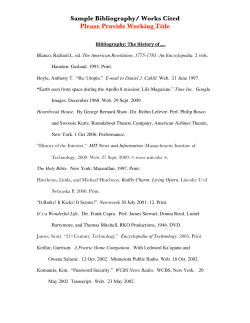
Cryogenic Nucleus Sample Return (CNSR) Hal Weaver JHU/APL
Cryogenic Nucleus Sample Return (CNSR) Hal Weaver JHU/APL hal.weaver@jhuapl.edu Key questions identified by the Decadal Survey and NASA Roadmap for Comets • • • What is the inventory of water and organic material across the Solar System and how has this matter evolved? How did comets contribute to the origin and evolution of planetary bodies? What are the bulk physical properties of comets, and what processes led to their formation and subsequent evolution? 2009 Oct 28 CNSR 2 Why CNSR? • The scientific importance of comets is tied directly to their role as tracers of early Solar System conditions – Cometary material preserves a signature of its origin in the solar nebula, and probably its ISM stage, even if comets are not completely “pristine” • Any sample return mission that can keep its cargo below the sample’s temperature in the nucleus, and preserve its physical structure, is clearly superior to a mission that cannot – The colder, the better (hence “cryogenic” is preferred) – Maintaining sample’s physical structure (e.g., crystalline vs amorphous) may be technically impossible for return to Earth’s surface • Depth of sample is important – Deeper is better, but depth “required” is uncertain scientifically, and going deeper is technically more challenging • Get the ice (aka “volatiles)! – Volatiles trace the coldest, most primitive conditions 2009 Oct 28 CNSR 3 Additional Questions Addressed by CNSR • How complex is cometary matter? – Do comets harbor the precursors of biological molecules? • Did comets supply a significant fraction of the Earth’s water and organics? • What is the detailed composition of cometary volatiles and how are they distributed vs depth in the nucleus? • What is the nature and source of cometary activity? – How does the energy exchange between the incoming solar radiation and near surface materials work? 2009 Oct 28 CNSR 4 Ice vs Rock • Ice traces the coldest, and Rock traces the hottest, conditions experienced by comets – Investigating both is important, but complementary in many respects • Crystalline grains in Stardust samples point to mixing across a large range of heliocentric distance in the solar nebula • Volatile inventory can be used to chart the thermal history of cometary material at temperatures ranging from ~10 K to 200 K • Are isotopic and noble gas abundances different for Ice vs Rock? 2009 Oct 28 CNSR 5 How Cold is Cold Enough? • Maintain T ≤263 K throughout entire mission to prevent aqueous alteration of the sample • Maintain T ≤135 K (amorphous to cubic ice transition) throughout entire mission – If ice is amorphous, preventing this phase change will help to preserve volatiles in the sample – But even this might not be cold enough during years of cruise • Preserving ice phase (e.g., crystalline vs amorphous) and physical structure requires mitigation of high-g environment, in addition to cryogenic temperatures – This requirement may be beyond even CNSR 2009 Oct 28 CNSR 6 Condensed (Ice) vs Gas Phase Volatiles • If you can’t maintain cold enough temperatures to preserve the ice sample during return, then at least collect the evolved gases – Must also store them in a way that prevents chemical changes (e.g., using special getters, different chambers filled at different temperatures) 2009 Oct 28 CNSR 7 How Deep is Deep Enough? Little is known about the vertical structure of the nucleus, but here’s one possible model Surface layer has diurnal thermal skin depth of a few cm Mass loss during typical perihelion passage corresponds to loss of ~1m averaged over nucleus Is the nucleus onion-structured with several different layers, with several different types of ice, and different compositions? CNSR should go meters, not centimeters, below the surface Prialnik 2004 2009 Oct 28 CNSR 8 D/H in the Solar System Multiple different values in multiple reservoirs What is this telling us? 2009 Oct 28 9 Did Cometary Bombardment Deliver Earth’s Water? Robert (2001) 2009 Oct 28 CNSR 10 • Noble gases in the Solar System tell an interesting story Venus has more Ar than Earth which has more Ar than Mars – What is the source of the Ar? Could it be comets? Xe/Kr is very different for chondrites than for Earth, Mars or Sun – what are cometary values? • Measuring the noble gases might require extremely high sensitivity if values in comets similar to chondrites 36Ar/[N] = 3x10-2 in Sun Might be 3-5 orders of magnitude lower in comets! 2009 Oct 28 CNSR 11 Perhaps exogenous delivery by comets that formed, and were maintained, at cold temperatures can explain the noble gas pattern observed for the terrestrial planets. If that’s the case, comets supplied other volatiles as well. 2009 Oct 28 CNSR 12 • Is there a preferred type of comet to sample? 2009 Oct 28 CNSR 13 46P/Wirtanen 73P/SW3-C • So far, no two look exactly alike • Hills, plains, spires, mesas, craters, sublimation pits, talps, … • Large variation in “active area” 81P/Wild2 67P/CG, 9P/Tempel 1 1P/Halley, 19P/Borrelly Diversity of Comet Nuclei
© Copyright 2025








